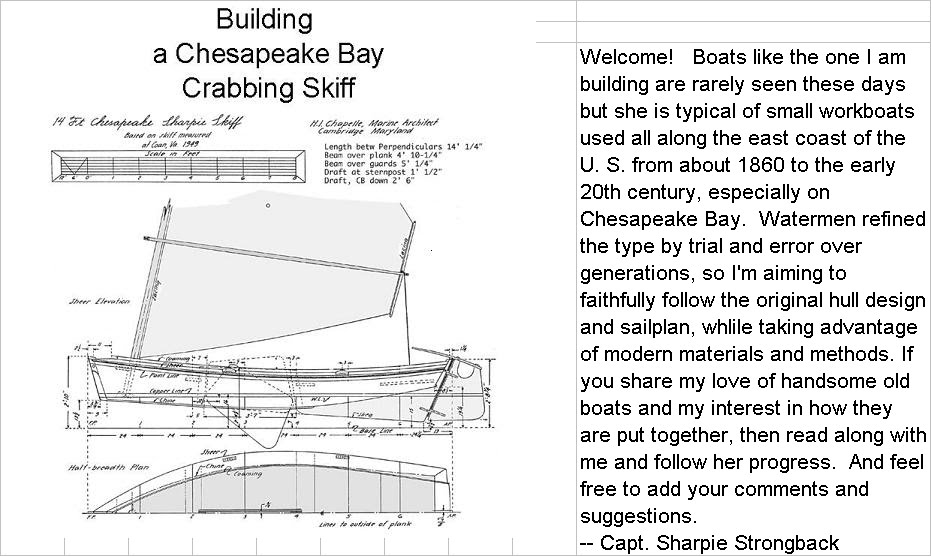
 Saturday, Feb. 15: I enjoyed today more than any other so far in the project. The result was I fit the chines in place, but getting there was the fun part.
Saturday, Feb. 15: I enjoyed today more than any other so far in the project. The result was I fit the chines in place, but getting there was the fun part.The chines (or more properly, the chine logs) form the inside of the corner between the sides and the bottom. They need to fit against the stem and the transom, which angle in both directions. The tricky part is that they must bend both around the boat’s side and also edgewise as the bottom rises near the stern. They must also twist as the boat’s sides do, going from bow to stern. And if that's not enough, the chine logs actually need to be about 2” longer than the space for them along the bottom, because of course the stem and transom angle away from each other. That last feature makes it not only hard to fit them in but also to figure how long to cut them.
 Two weeks ago I sweated the chines into place over the course of two days with the help of my friend Capt. JT. But in case you missed or forgot that sad chapter, our effort came to grief because the stem angle was wrong and one of the chines was cut too short. Work since then has been remediation.
Two weeks ago I sweated the chines into place over the course of two days with the help of my friend Capt. JT. But in case you missed or forgot that sad chapter, our effort came to grief because the stem angle was wrong and one of the chines was cut too short. Work since then has been remediation.Correcting the stem angle moved the chines back a little, but not enough for the short chine to gain its deficiency. I had to use new pieces for the chines this time around.
I started the day by making short pattern pieces for the bow and the stern ends of the chine, so I would know exactly what angles the cut them. I cut the bow ends of both chines to those angles.
Because they bend so many ways at once, I didn’t know if I would be able to fit the chines without help. But I did know there had to be a better way to hold them in place while they were being installed. During one of my middle-of-the-night musings a way to do that occurred to me. Now, I have learned over and over again that great ideas in the middle of the night usually are not worth much in daylight. But my idea was to make clamps to hold the chines in place against the side, and also secure their vertical position. I went to the hardware store for a 2 by 4 and four strap hinges. I sawed the 2x4 in half lengthwise and cut the two lengths into four matching pairs two feet long. I joined each pair at one end with a strap hinge, and cut a notch out of one side of each pair to match the cross section of the chine. Clamps done and ready to use. To use a chine clamp, I hang the hinged pieces over the boat with the notch over the chine on the inside, and clamp the two ends together, pinching against the boat’s side panel. Not only does it hold the chine in place, but also I can fine tune the height by tapping the top or bottom of the chine clamp. My idea works even better than I'd hoped, and I’m so pleased with myself I could spit.
I put the bow ends of the chines up against the stem on each side, and using my chine clamps I gradually worked toward the stern, screwing the chine in place on alternate sides, checking frequently that the bow stayed on center. Compared to a struggling two-man job last time, it was a straightforward process to do it alone, thanks to my magic chine clamps.
As I approached the stern on each side, I let the uncut chines run over the transom, measured how long they needed to be, and cut them by hand to the right angle and length, using the short template piece as a guide. Then I loosened the sides from the transom, dropped the chines into place, reattached the sides to the transom, and finished screwing the chines to the sides;finishing the job just as I ran out of daylight. I won’t claim the fits were perfect, but close to it.
Everything went well today, and I am well pleased to get the chines to a good dry fit. I won’t claim total victory over them until they are epoxied in place.
As I approached the stern on each side, I let the uncut chines run over the transom, measured how long they needed to be, and cut them by hand to the right angle and length, using the short template piece as a guide. Then I loosened the sides from the transom, dropped the chines into place, reattached the sides to the transom, and finished screwing the chines to the sides;finishing the job just as I ran out of daylight. I won’t claim the fits were perfect, but close to it.
Everything went well today, and I am well pleased to get the chines to a good dry fit. I won’t claim total victory over them until they are epoxied in place.

Great idea for the clamp. In Singapore they flog you with bamboo poles for spitting. In the US we are still allowed to spit at home. Keep up the spitting good innovations.
ReplyDeleteWell, flog me with a bamboo pole. It's worth it.
ReplyDelete